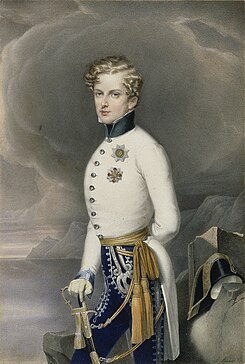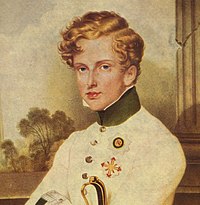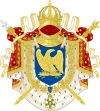Napoleon II
| Napoleon II | |||||
|---|---|---|---|---|---|
 Portrait by Leopold Bucher | |||||
| Emperor of the French Disputed | |||||
| Tenure | 22 June 1815 – 7 July 1815 | ||||
| Predecessor | Napoleon I | ||||
| Successor | Louis XVIII as King of France and Navarre | ||||
| Regent | Joseph Fouché | ||||
| King of Rome | |||||
| Tenure | 20 March 1811 – 11 April 1814 | ||||
| Duke of Reichstadt | |||||
| Tenure | 22 July 1818 – 22 July 1832 | ||||
| Born | 20 March 1811 Tuileries Palace, Paris, French Empire | ||||
| Died | 22 July 1832 (aged 21) Schönbrunn Palace, Vienna, Austrian Empire | ||||
| Burial | Les Invalides, Paris, France | ||||
| |||||
| House | Bonaparte | ||||
| Father | Napoleon I, Emperor of France | ||||
| Mother | Archduchess Marie Louise, Duchess of Parma | ||||
| Religion | Roman Catholicism | ||||
Napoléon François Charles Joseph Bonaparte (20 March 1811 – 22 July 1832), Prince Imperial, King of Rome, known in the Austrian court as Franz from 1814 onward, Duke of Reichstadt from 1818, was the son of Napoleon I, Emperor of the French, and his second wife, Archduchess Marie Louise of Austria.
By Title III, article 9 of the French Constitution of the time, he was Prince Imperial, but he was also known from birth as the King or ruler of Rome, which Napoleon I declared was the courtesy title of the heir apparent. His nickname of L'Aiglon ("the Eaglet") was awarded posthumously and was popularized by the Edmond Rostand play, L'Aiglon.
When Napoleon I tried to abdicate on 4 April 1814, he said that his son would rule as Emperor. However, the coalition partners that had defeated him refused to acknowledge his son as successor; thus Napoleon I was forced to abdicate unconditionally a number of days later. Although Napoleon II never actually ruled France, he was briefly the titular Emperor of the French in 1815 after the fall of his father. When his cousin Louis-Napoléon Bonaparte became the next emperor by founding the Second French Empire in 1852, he called himself Napoleon III to acknowledge Napoleon II and his brief reign.
Biography
This section needs additional citations for verification. (April 2017) |

Birth
Napoleon was born on 20 March 1811 at the Tuileries Palace, son of Napoleon I and Empress Marie Louise. On the same day he was ondoyed (a traditional French ceremony which is considered a preliminary, brief baptism) by Joseph Fesch with his full name of Napoleon François Charles Joseph.[1] The baptism, inspired by the baptismal ceremony of Louis, Grand Dauphin of France, was held on 9 June 1811 in the Notre Dame de Paris cathedral.[1] Karl Philipp, Prince of Schwarzenberg, Austrian ambassador to France, wrote of the baptism:
The baptism ceremony was beautiful and impressive; the scene in which the emperor took the infant from the arms of his noble mother and raised him up twice to reveal him to the public [thus breaking from long tradition, as he did when he crowned himself at his coronation] was loudly applauded; in the monarch's manner and face could be seen the great satisfaction that he took from this solemn moment.[1]
He was put in the care of Louise Charlotte Françoise Le Tellier de Montesquiou, a descendant of François-Michel le Tellier, Marquis de Louvois, who was named Governess of the Children of France. Affectionate and intelligent, the governess assembled a considerable collection of books intended to give the infant a strong grounding in religion, philosophy and military matters.[1]
Succession rights
As the eldest legitimate son of Napoleon I, he was already constitutionally the Prince Imperial and heir apparent, but the Emperor also gave his son the style of King of Rome.
Three years later, the First French Empire, to which he was the heir, collapsed. Napoleon saw his second wife and their son for the last time on 24 January 1814.[2] On 4 April 1814, Napoleon abdicated in favour of his three-year-old son after the Six Days' Campaign and the Battle of Paris. The child became Emperor of the French under the regnal name of Napoleon II. However, on 6 April 1814, Napoleon I fully abdicated and renounced not only his own rights to the French throne, but also those of his descendants. The Treaty of Fontainebleau in 1814 gave the child the right to use the title of Prince of Parma, of Placentia, and of Guastalla, and his mother was styled the Duchess of Parma, of Placentia, and of Guastalla.
Reign
On 29 March 1814, accompanied by her suite, Marie Louise left the Tuileries Palace with her son. Their first stop was the Château de Rambouillet; then, fearing the advancing enemy troops, they continued on to the Château de Blois. On 13 April, with her suite much diminished, Marie Louise and her three-year-old son were back in Rambouillet, where they met her father, the Emperor Francis I of Austria, and the Emperor Alexander I of Russia. On 23 April, escorted by an Austrian regiment, mother and son left Rambouillet and France forever, for their exile in Austria.[3]
In 1815, after his defeat at Waterloo, Napoleon I abdicated for the second time in favour of his four-year-old son, whom he had not seen since his exile to Elba. The day after Napoleon's abdication, a Commission of Government of five members took the rule of France,[4] awaiting the return of King Louis XVIII, who was in Le Cateau-Cambrésis.[5] The Commission held power for two weeks, but never formally summoned Napoleon II as Emperor or appointed a regent. The entrance of the Allies into Paris on 7 July brought a rapid end to his supporters' wishes. Napoleon II was residing in Austria with his mother and was probably not aware at the time that he had been proclaimed Emperor on his father's abdication.
The next Bonaparte to ascend the throne of France would be Louis-Napoleon, the son of Napoleon's brother Louis I, King of Holland, in 1852. He took the regnal name of Napoleon III.

Life in Austria
From the spring of 1814 onwards, Napoleon lived in Austria and was known as "Franz", his second given name. In 1818, he was awarded the title of Duke of Reichstadt by his maternal grandfather, Emperor Francis. He was educated by a staff of military tutors and developed a passion for soldiering, dressing in a miniature uniform like his father's and performing maneuvers in the palace. At the age of 8, it was apparent to his tutors that he had chosen his career.
By 1820, Napoleon had completed his elementary studies and begun his military training, learning German, Italian and mathematics as well as receiving advanced physical training. His official army career began at age 12, in 1823, when he was made a cadet in the Austrian Army. Accounts from his tutors describe Napoleon as intelligent, serious and focused. Additionally, he was a very tall young man: he had grown to nearly 6 feet by the time he was 17.
His budding military career gave some concern and fascination to the monarchies of Europe and French leaders over his possible return to France. However, he was allowed to play no political role and instead was used by Austrian Chancellor Klemens von Metternich in bargaining with France to gain advantage for Austria. Fearful of anyone in the Bonaparte family regaining political power, Metternich even rejected a request for Franz to move to a warmer climate in Italy. He received another rejection when his grandfather refused to allow him to be part of the army traveling to Italy to put down a rebellion.[6]
Upon the death of his stepfather, Adam Albert von Neipperg, and the revelation that his mother had borne two illegitimate children to him prior to their marriage, Franz grew distant from his mother and felt that his Austrian family were holding him back to avoid political controversy. He said to his friend, Anton von Prokesch-Osten, "If Josephine had been my mother, my father would not have been buried at Saint Helena, and I should not be at Vienna. My mother is kind but weak; she was not the wife my father deserved".[7]

Death
In 1831, Franz was given command of an Austrian battalion, but he never got the chance to serve in any meaningful capacity. In 1832, he caught pneumonia and was bedridden for several months. His poor health eventually overtook him and on 22 July 1832 Franz died of tuberculosis at Schönbrunn Palace in Vienna.[8] He left no issue; thus the Napoleonic claim to the throne of France passed to his cousin, Louis-Napoléon Bonaparte, who later successfully restored the empire as Napoleon III.
Disposition of his remains

On 15 December 1940, Adolf Hitler ordered the remains of Napoleon II to be transferred from Vienna to the dome of Les Invalides in Paris.[9][10] The remains of Napoleon I had been returned to France in December 1840, at the time of the July Monarchy.[11] For some time, the remains of the young prince who had briefly been an emperor rested beside those of his father. Later, the prince's remains were moved to the lower church.
While most of his remains were transferred to Paris, his heart and intestines remained in Vienna, which is traditional for members of the Habsburg house. They are in Urn 42 in the "Heart Crypt" (Herzgruft) and his viscera are in Urn 76 of the Ducal Crypt.
Legacy
- Napoleon II was also known as "The Eaglet" (French: L'Aiglon). In 1900, Edmond Rostand wrote a play, L'Aiglon, about his life.
- Serbian composer Petar Stojanović composed the operetta Napoleon II: Herzog von Reichstadt, which premiered in Vienna in the 1920s.
- Victor Tourjansky directed a French-language film titled L'Aiglon in 1931, and he also directed a separate German-language version.
- Arthur Honegger and Jacques Ibert collaborated on an opera, L'Aiglon, which premiered in 1937.
- The journalist Henri Rochefort joked that Napoleon II, having never really governed, was France's best leader, since he brought no war, taxes or tyranny.[12]
- Neil Tennant of the Pet Shop Boys wrote the lyrics of the song King of Rome, on their album Yes, referring to Napoleon II.
- Dean M. Drinkel and Romain Collier wrote the feature film script "The Tragedy Of The Duke Of Reichstadt", which won two screenplay awards at the 2016 Monaco International Film Festival and which goes into production in 2018.
He was noted for his friendship with Sophie, a Bavarian princess of the House of Wittelsbach.[13] Intelligent, ambitious and strong-willed, Sophie had little in common with her husband Franz Karl. There were rumors of a relationship between Sophie and Napoleon II, as well as the possibility that Sophie's second son, Maximilian I of Mexico (born 1832), was the result of their reciprocal involvement.
Titles, styles, arms and honours
Titles and styles
- 20 March 1811 - 6 April 1814: His Imperial Highness The King of Rome
- 6 April 1814 - 22 July 1818: His Serene Highness The Prince of Parma, of Placentia, and of Guastalla
- 20 March 1815 - 22 June 1815: His Imperial Highness The Prince Imperial of France
- 22 June 1815 - 7 July 1815: His Imperial Majesty The Emperor of the French
- 22 July 1818 - 22 July 1832: His Serene Highness The Duke of Reichstadt
- in pretense: 7 July 1815 - 22 July 1832: His Imperial Majesty Emperor Napoleon II
Honours
 Austrian Empire: Knight Grand Cross of the Order of Saint Stephen of Hungary
Austrian Empire: Knight Grand Cross of the Order of Saint Stephen of Hungary First French Empire: Grand Eagle of the Legion of Honour
First French Empire: Grand Eagle of the Legion of Honour Kingdom of Italy: Order of the Iron Crown, 1st Class
Kingdom of Italy: Order of the Iron Crown, 1st Class Duchy of Parma: Knight Grand Cross of the Sacred Military Constantinian Order of Saint George
Duchy of Parma: Knight Grand Cross of the Sacred Military Constantinian Order of Saint George
Coat of arms
-
King of Rome
-
Duke of Reichstadt [14] (1818–32)
Ancestry
| Ancestors of Napoleon II | ||||||||||||||||||||||||||||||||||||||||||||||||||||||||||||||||||||||||||||||||||||||||||||||||||||||||||||||||||||||||||||||||||||||||||||||||||||||||||||||||||||||||||||||||||||||||||||||||||||||||||||||||||||||||||||||||||||||||||||||||||||||||||||||||||||||||||||||||||||||||||||||||||||||||||||||||||||||||||||||||||||||||||||||||||||||||||||||||||||||||||||||||||||||||||||||||||||||||||||||||||||||||||||||||||||||||||||||||||||||||||||||||||||||||||||||||||||||||||||||||||||||||||||||||||||||||||||||||||||||||||||||||||||||||||||||||||||||||||||||||||||||||||||||||||||||||||||||||
|---|---|---|---|---|---|---|---|---|---|---|---|---|---|---|---|---|---|---|---|---|---|---|---|---|---|---|---|---|---|---|---|---|---|---|---|---|---|---|---|---|---|---|---|---|---|---|---|---|---|---|---|---|---|---|---|---|---|---|---|---|---|---|---|---|---|---|---|---|---|---|---|---|---|---|---|---|---|---|---|---|---|---|---|---|---|---|---|---|---|---|---|---|---|---|---|---|---|---|---|---|---|---|---|---|---|---|---|---|---|---|---|---|---|---|---|---|---|---|---|---|---|---|---|---|---|---|---|---|---|---|---|---|---|---|---|---|---|---|---|---|---|---|---|---|---|---|---|---|---|---|---|---|---|---|---|---|---|---|---|---|---|---|---|---|---|---|---|---|---|---|---|---|---|---|---|---|---|---|---|---|---|---|---|---|---|---|---|---|---|---|---|---|---|---|---|---|---|---|---|---|---|---|---|---|---|---|---|---|---|---|---|---|---|---|---|---|---|---|---|---|---|---|---|---|---|---|---|---|---|---|---|---|---|---|---|---|---|---|---|---|---|---|---|---|---|---|---|---|---|---|---|---|---|---|---|---|---|---|---|---|---|---|---|---|---|---|---|---|---|---|---|---|---|---|---|---|---|---|---|---|---|---|---|---|---|---|---|---|---|---|---|---|---|---|---|---|---|---|---|---|---|---|---|---|---|---|---|---|---|---|---|---|---|---|---|---|---|---|---|---|---|---|---|---|---|---|---|---|---|---|---|---|---|---|---|---|---|---|---|---|---|---|---|---|---|---|---|---|---|---|---|---|---|---|---|---|---|---|---|---|---|---|---|---|---|---|---|---|---|---|---|---|---|---|---|---|---|---|---|---|---|---|---|---|---|---|---|---|---|---|---|---|---|---|---|---|---|---|---|---|---|---|---|---|---|---|---|---|---|---|---|---|---|---|---|---|---|---|---|---|---|---|---|---|---|---|---|---|---|---|---|---|---|---|---|---|---|---|---|---|---|---|---|---|---|---|---|---|---|---|---|---|---|---|---|---|---|---|---|---|---|---|---|---|---|---|---|---|---|---|---|---|---|---|---|---|---|---|---|---|---|---|---|---|---|---|---|---|---|---|---|---|---|---|---|---|---|---|---|---|---|---|---|---|---|---|---|---|---|---|---|---|---|---|---|---|---|---|---|---|---|---|---|---|---|---|---|---|---|---|---|---|---|---|---|---|---|---|---|---|---|---|---|---|---|---|---|---|---|---|---|---|---|---|---|---|---|---|---|---|---|---|---|---|---|---|---|---|---|---|---|---|---|---|---|---|---|---|---|---|---|---|---|---|---|---|---|---|---|---|---|---|
| ||||||||||||||||||||||||||||||||||||||||||||||||||||||||||||||||||||||||||||||||||||||||||||||||||||||||||||||||||||||||||||||||||||||||||||||||||||||||||||||||||||||||||||||||||||||||||||||||||||||||||||||||||||||||||||||||||||||||||||||||||||||||||||||||||||||||||||||||||||||||||||||||||||||||||||||||||||||||||||||||||||||||||||||||||||||||||||||||||||||||||||||||||||||||||||||||||||||||||||||||||||||||||||||||||||||||||||||||||||||||||||||||||||||||||||||||||||||||||||||||||||||||||||||||||||||||||||||||||||||||||||||||||||||||||||||||||||||||||||||||||||||||||||||||||||||||||||||||
Sources
- Welschinger, Le roi de Rome, 1811–32, (Paris, 1897)
- Wertheimer, The Duke of Reichstadt, (London, 1905)
References
- ^ a b c d "Napoleon II: King of Rome, French Emperor, Prince of Parma, Duke of Reichstadt". The Napoleon Foundation. napoleon.org. March 2011. Retrieved 8 March 2012.
- ^ "Château de Fontainebleau". Musee-chateau-fontainebleau.fr. Retrieved 2012-08-28.
- ^ G. Lenotre, le Château de Rambouillet, six siècles d'histoire, ch. L'empereur, Éditions Denoël, Paris, 1984 (1930 reedition), pp. 126–133, ISBN 2-207-23023-6.
- ^ "(N.275.) Arrete par lequel la Commission du Gouvernement se constitue sous la présidence M. le Duc d'Otrante". Bulletin des lois de la République française (in French). 23 June 1815. p. 279.
- ^ "(N. 1.) Proclamation du Roi". Bulletin des lois de la République française (in French). 25 June 1815. p. 1.
- ^ Napoleon II Biography
- ^ Markham, Felix, Napoleon, p. 249
- ^ Altman, Gail S. Fatal Links: The Curious Deaths of Beethoven and the Two Napoleons (Paperback). Anubian Press (September 1999). ISBN 1-888071-02-8
- ^ Poisson, Georges, (Robert L. Miller, translator), Hitler's Gift to France: The Return of the Ashes of Napoleon II, Enigma Books, ISBN 978-1-929631-67-4 (Synopsis & Review by Maria C. Bagshaw).
- ^ Poisson, Georges, Le retour des cendres de l'Aiglon, Édition Nouveau Monde, Paris, 2006, ISBN 2847361847 French wags at the time countered Hitler's propaganda by saying "Hitler stole France's coal, but returned to them the ashes." (French)
- ^ Driskel, Paul (1993). As Befits a Legend. Kent State University Press. p. 168 ISBN 0-87338-484-9
- ^ Leo A. Loubere, Nineteenth-Century Europe: The Revolution of Life, Englewood Cliffs, New Jersey: Prentice Hall, p. 154.
- ^ Palmer 1994, p. 3.
- ^ Hassel, Georg (1 January 1830). "Genealogisch-historisch-statistischer Almanach". im Verlag des Landes-Industrie-Comptoirs. – via Google Books.
External links
- 1811 births
- 1832 deaths
- House of Bonaparte
- French emperors
- Princes of Andorra
- Princes of France (Bonaparte)
- Bonapartist pretenders to the French throne
- First French Empire
- Grand Croix of the Légion d'honneur
- Commandeurs of the Ordre des Palmes Académiques
- Knights of the Golden Fleece
- Knights of the Order of Saint Stephen of Hungary
- Knights of the Sacred Military Constantinian Order of Saint George
- Roman Catholic monarchs
- People from Paris
- Rulers deposed as children
- 19th-century rulers in Europe
- 19th-century deaths from tuberculosis
- 19th-century French monarchs
- 19th-century Princes of Andorra
- Tuberculosis deaths in Austria



![Duke of Reichstadt [14] (1818–32)](http://upload.wikimedia.org/wikipedia/commons/thumb/0/0e/Coat_of_Arms_of_the_Duke_of_Reichstadt_%28Variant_2%29.svg/116px-Coat_of_Arms_of_the_Duke_of_Reichstadt_%28Variant_2%29.svg.png)



